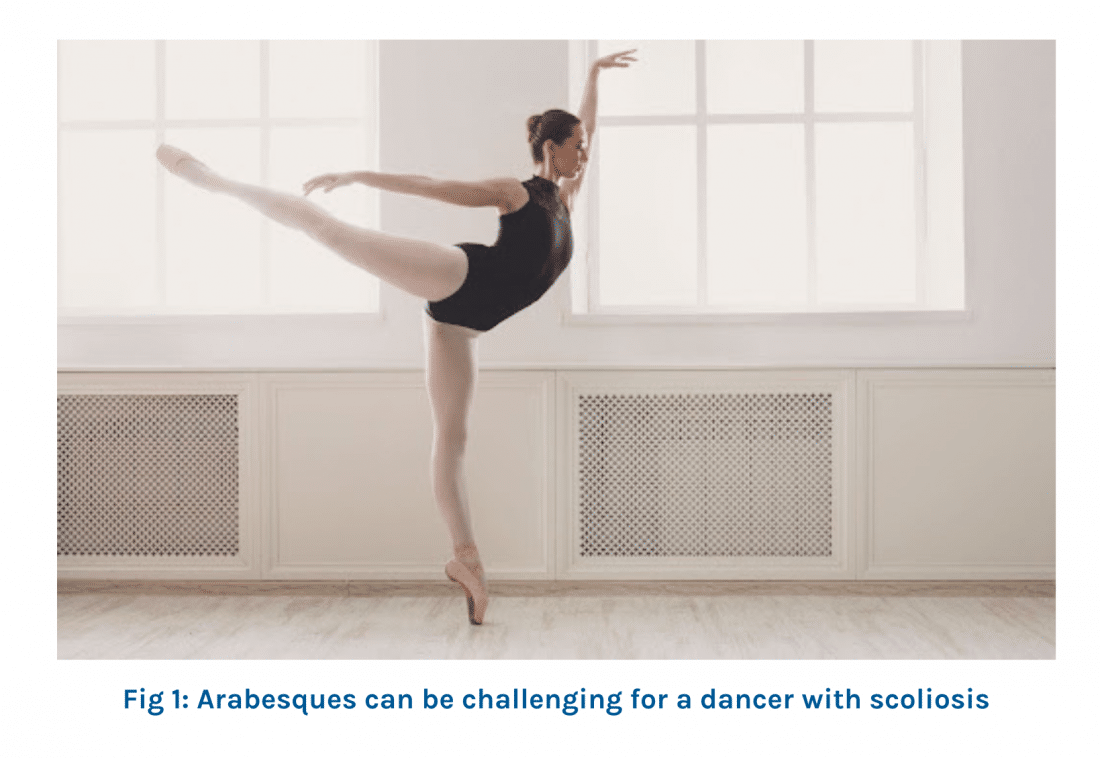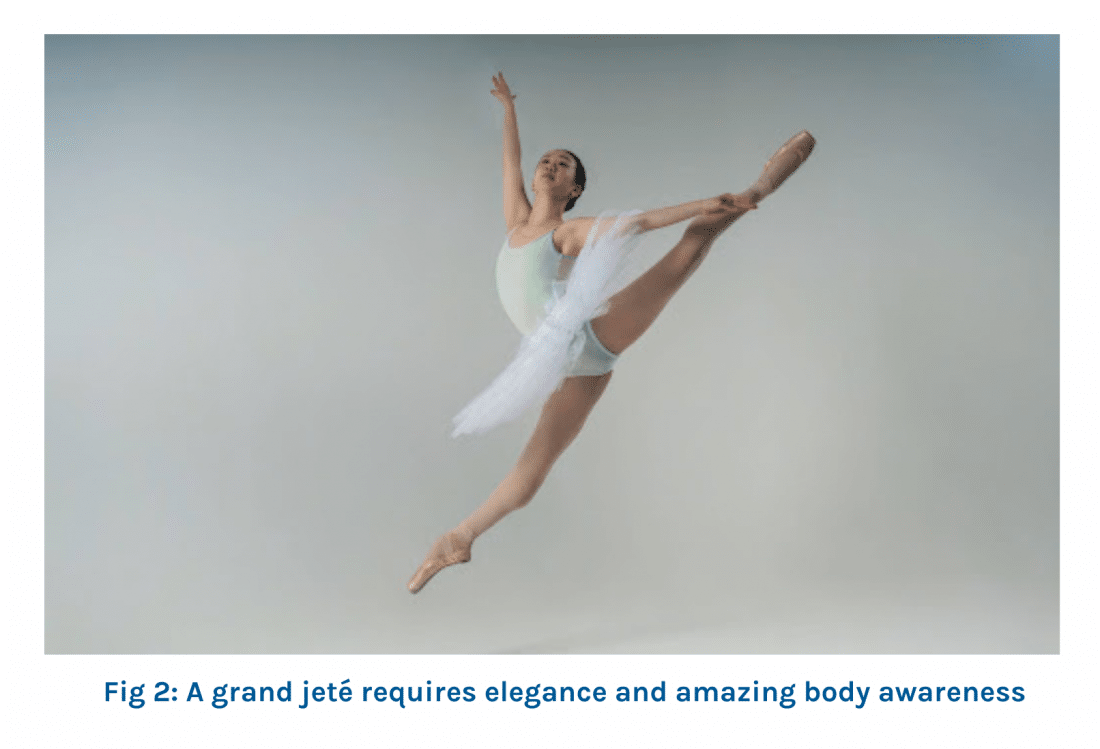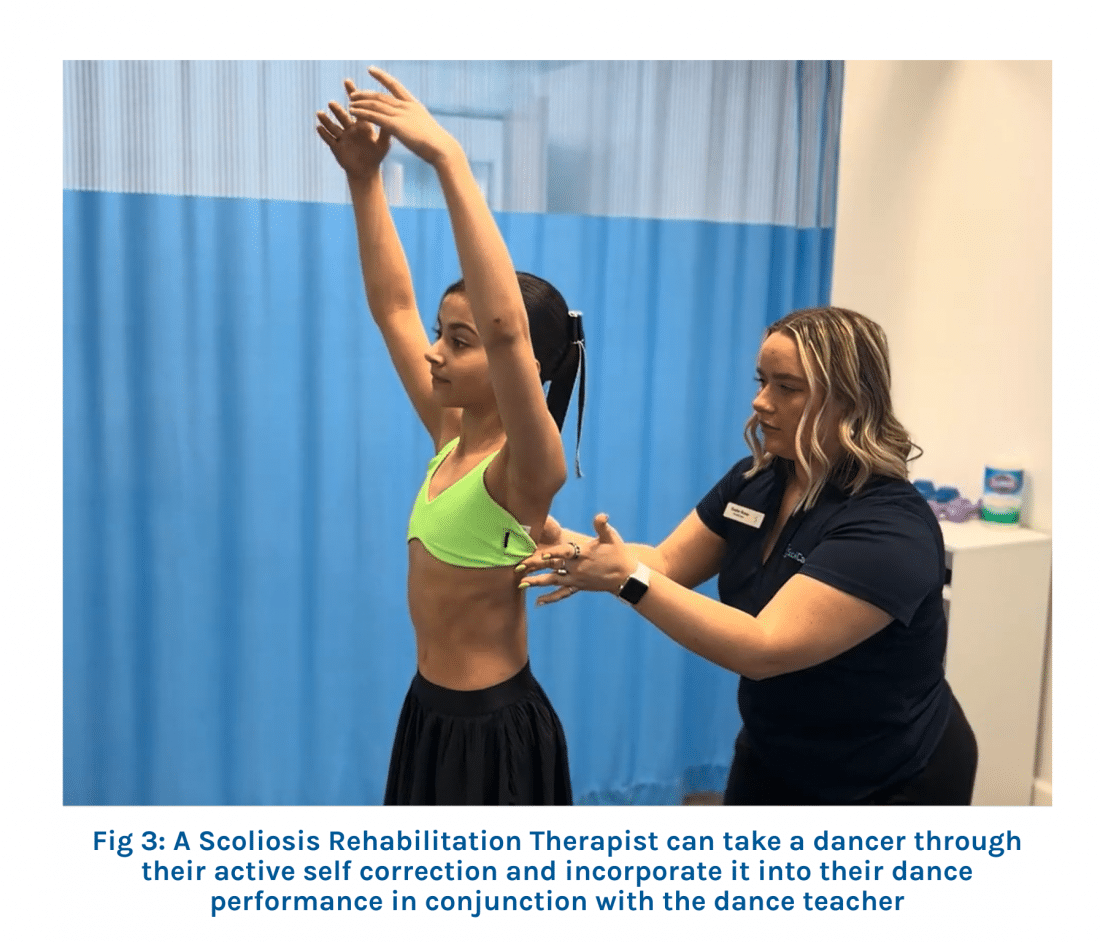Dance is an art of precision, strength, and grace – a symphony of movement where every line and leap counts. For dancers with scoliosis, a condition defined by an abnormal lateral spinal curvature exceeding 10 degrees with rotation, this symphony can hit unexpected notes.
Often emerging during the growth spurts of adolescence, prime years for dance training, scoliosis doesn’t end a career, but it reshapes the journey. It affects flexibility, balance, and stamina in ways every dancer, teacher, and parent should grasp. Here’s how it influences performance, and how to navigate it confidently.
The Physical Ripple Effect
Scoliosis alters the spine’s natural alignment, causing deviations in the spine’s alignment and shape of the rib cage and torso that ripples through the body. For dancers, this isn’t just a structural shift, it’s a performance challenge. Consider flexibility: a 30-degree thoracic curve might tighten some muscles of the back, making arabesques (Fig 1) or cambrés more challenging. A dancer might notice one side bends less fluidly, complicating choreography that demands seamless extensions or deep pliés.
Balance takes a hit too. The spine’s asymmetry shifts the body’s center of gravity, tilting the pelvis or shoulders. A dancer with a lumbar curve might wobble in pirouettes or struggle with sustained relevés, as the uneven foundation throws off stability. Stamina also suffers – tightened muscles or a distorted rib cage can restrict breathing, leaving a dancer breathless mid-pas de deux. These aren’t career-enders, but they require awareness and adjustment.
The spine’s asymmetry [in scoliosis] shifts the body’s center of gravity, tilting the pelvis or shoulders.

The Mind-Body Connection
Beyond the physical, scoliosis may affect a dancer’s psyche. Dance thrives on confidence, yet a visible curve, or perhaps a protruding rib prominence in a leotard, can spark self-doubt. Young dancers might feel this keenly in a mirror-filled studio, hesitating during auditions or shying from lifts, worried their form stands out for the wrong reasons.
Pain adds another layer. Though not universal, some dancers with scoliosis feel discomfort, especially after long rehearsals. A 40-degree curve might trigger a nagging ache in class, quietly eroding focus, but it’s not all linked to the size of the curve. Even dancers with small curves may have pain. Teachers and parents need to spot these cues before they derail progress.
Scoliosis can affect the posture, causing asymmetries, but the brain will also start to adapt and think the body is upright and straight.
Performance in Practice
How does this play out on stage? A dancer with a mild 15-degree curve might glide through with minor tweaks, but true instruction on how to correct their posture will need to be guided by a health professional specifically trained in scoliosis. For those with moderate (25–40 degrees) or severe (over 40 degrees) curves, the stakes climb. A grand jeté (Fig 2) might land off-kilter, or a partnered adagio could falter if asymmetry disrupts alignment. If not already under the care of a scoliosis specific health professional, now is the time. The earlier the referral, the earlier the diagnosis, and then the more likely that treatment can slow or reverse the curve.

These days we know that physiotherapeutic scoliosis specific exercises (PSSE) and bracing can improve or slow down a curve’s progression in many instances. A PSSE program, such as ScoliBalance, will be able to teach the dancer how to active self correct their posture in 3D. Let’s talk about that more below (Fig 3). 
Strategies for Dancers
Dancers with scoliosis can adapt and thrive with practical steps:
- Strengthen Smart: Each dancer with scoliosis will benefit from a PSSE program, such as ScoliBalance, to ensure they know how to correct their posture in 3D. While all other strengthening can be useful, they are likely to be strengthened in their scoliotic posture, rather than a corrected posture.
- Support the Use of the Brace: For dancers with moderate to severe curves, they may be prescribed a custom 3D overcorrective brace. They may choose not to dance in their brace but ideally they should be arriving and leaving training in their brace.
- Brace with Balance: If wearing a brace, stick to the recommended hours but negotiate studio time. The patient can often ‘buy’ time to be out of brace by actually being active!
- Listen Up: Rest when discomfort flares, and they may need an earlier review with their Scoliosis Clinician if this happens.
Guidance for Teachers
Dance teachers shape how scoliosis unfolds in the studio:
- Spot the Signs: Notice uneven hips, a tilted head, or one-sided fatigue. Catching these early means quicker solutions.
- Modify Moves: Tweak choreography, such as adjusting a port de bras to favor a dancer’s stronger side, without spotlighting them. Subtlety boosts confidence.
- Adapt, Don’t Overrule: Work with parents to align class with scoliosis appointment schedules. Flexibility here keeps dancers in the game.
- Foster Teamwork: Build a supportive vibe in group warm-ups or buddy checks, so differences don’t dim talent.
Advice for Parents
Parents anchor a dancer’s scoliosis journey:
- Screen Early: Check for curves around 10–12 years of age, when scoliosis often shows. A quick forward bend test at home can signal early signs.
- Seek Professionals: Consult a health professional specifically trained in scoliosis management, for a tailored plans. Early steps can shift outcomes.
- Support, Don’t Push: Validate feelings about braces or body changes. Encouragement here builds resilience.
- Balance Dance and Health: Team up with teachers to prioritise spine care over perfection.
The Bigger Picture
Scoliosis bends the spine, not the spirit. Many braced dancers avoid surgery and still shine, turning challenges into strengths. Teachers and parents amplify this by supporting and encouraging resilience.
What’s the takeaway? Understand scoliosis’ impact on flexibility, balance, stamina, psyche, and meet it with strategy. Whether you’re a dancer refining a développé, a teacher adjusting a routine, or a parent cheering from the wings, scoliosis doesn’t define the performance.
🎯 Scoliosis doesn’t end a dance journey—it just reshapes it. If you’re a parent, teacher, or dancer who’s noticed changes in posture, flexibility, or balance, now is the time to act. Early detection can open the door to better outcomes.


#StrongSpinesStrongFutures


